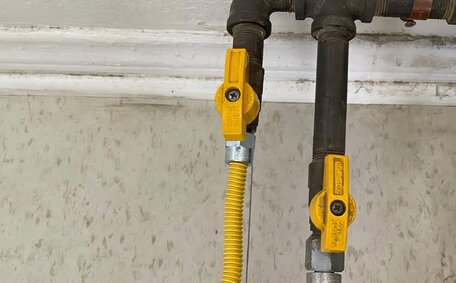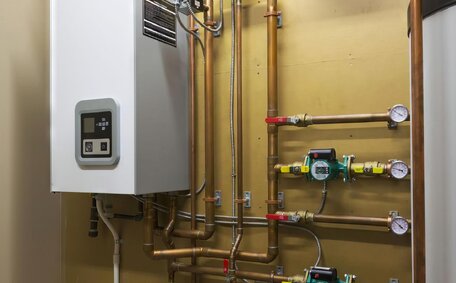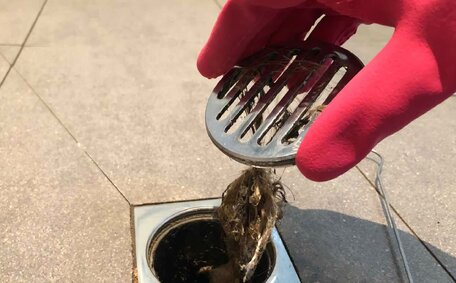What is a Pilot Light and Why is it Important?
A pilot light is a small, continuous flame within your gas water heater, critical for igniting the main gas burner to heat water as required.
The pilot light allows for automatic ignition of the main burner. This means you have instant access to hot water whenever a tap is turned on, without needing to manually light the water heater each time. The pilot light flame needs to stay lit at all times for this purpose.
A functional pilot light is key to a steady hot water supply from your gas heater. If the pilot light goes out, the main burner cannot ignite, and you will temporarily lose access to heated water until the pilot is relit. Maintaining the pilot light is therefore essential for the functionality of the hot water system.
Safety First: Precautions Before Relighting the Pilot
Safety should always come first when dealing with gas appliances. Take precautions before attempting to relight your water heater’s pilot light.
Firstly, sniff around the heater and listen for hissing to detect gas leaks.
If you detect a leak, leave the area immediately and call the gas company or a professional plumber.
Verify that no potential ignition sources, like open flames, are near the water heater. This encompasses active electrical devices, lit cigarettes, lighters, and similar items. Also clear any flammable materials such as laundry or cleaning products from the vicinity.
Turn the gas control dial clockwise to 'off’ and wait 5 minutes to allow gas to dissipate. This gives time for any built up gas to dissipate.
Once the area is free of leaks, potential ignition sources and has aired out, you can proceed to the next step to light the pilot anew.
Locating the Pilot Light Assembly
The pilot light assembly is typically located behind an access panel at the base of the water heater. Look for a secured removable panel, typically metal or plastic, to access the pilot light assembly.
Remove the panel to reveal the inner components of the water heater. Inside, locate the pilot tube, a thin metallic conduit.
You should see a small flame which is the pilot light.
Beside the pilot there will also be a gas control dial to adjust the pilot flame, and a piezo igniter button for relighting the pilot manually. Check for a thermocouple, as it detects whether the pilot light is on.
Use a flashlight to carefully inspect these components up close. Locate any specifics such as the model or serial number printed directly on the water heater. Make note of the layout and familiarise yourself with the pilot area before attempting to relight.
If the configuration is atypical, consult the user manual. Reach out to the manufacturer or call a professional for guidance if needed.
Tools You’ll Need
For relighting the pilot light, you’ll need specific tools:
- Flashlight - Essential for seeing inside the dark water heater cabinet and locating the pilot assembly.
- Long-reach lighter or matches - Many pilot assemblies are too far back in the cabinet to reach with a regular lighter. Use an extended barbecue lighter or long fireplace matches.
- Screwdriver - May be needed to open an access panel secured by screws.
- User manual - Refer to the manufacturer’s instructions for your specific water heater model for specialised equipment or steps.
Depending on your water heater model, you might also need:
- Protective gloves - If you need to remove hot flue components to access the pilot.
- Brush - To dust off and properly see the pilot area.
- Steel wool - For polishing corrosion off the thermocouple if the pilot won’t stay lit.
- Replacement igniter - In case your built-in igniter button fails and won’t produce a spark.
Ensure all necessary tools are collected before starting the process. Refer to your user manual or contact the manufacturer if you are unsure of what you will need for relighting the pilot on your particular water heater model.
Step-by-Step: Manually Relighting the Pilot
Follow these step-by-step instructions to manually relight the pilot, ensuring your gas water heater functions optimally:
- Ensure you have taken all necessary safety precautions mentioned previously.
- Fully turn the gas control valve to the "Off" position.
- Wait 5 minutes for any residual gas to dissipate.
- Remove the access panel at the base of the water heater.
- Using a flashlight, find the pilot assembly including the pilot tube, gas control, igniter and thermocouple.
- Depress and hold the gas control knob to open gas flow. This opens the gas flow and allows you to light the pilot.
- Bring your long barbecue lighter or lit match to the end of the pilot tube. Relight the pilot by igniting the gas coming out while continuing to hold in the gas control dial/knob.
- Continue holding the dial/knob for 30 seconds after the pilot flame lights. This heats the thermocouple to signal the gas valve to remain open.
- Release the dial/knob. If the pilot light remains lit, the relight was successful. If it goes out, repeat steps 6-8.
- Replace the access panel and turn gas control dial to "On". The main burner will automatically ignite to start reheating the water whenever needed.
If the pilot flame will not stay lit after several attempts at the above steps, call a professional for assistance. There may be an issue with the thermocouple or gas control valve.
Using an Electronic Igniter
Many modern gas water heaters come equipped with an electronic igniter for added convenience and safety when relighting the pilot.
The initial steps are similar to the manual process:
- Turn off the gas at the control knob/valve
- Wait 5 minutes
- Remove the access panel
- Locate the pilot assembly
The electronic igniter removes the need for an external flame source. Look for the marked 'igniter’ button. To relight:
- Depress the gas control knob to allow fuel flow to the pilot
- Press and hold the igniter button until you hear a "clicking" sound. You may see a small spark within the pilot tube.
- Continue holding the igniter button down for 30 seconds to heat the thermocouple and signal the gas valve to stay open
- Release the gas control knob
- If the pilot stays lit, the electronic relight was successful. Replace the access panel and set gas control to "On" position.
The electronic igniter eliminates the need for matches or lighters. Should relighting with the igniter fail after multiple tries, seek professional help.
Ensuring the Pilot Stays Lit
Once the pilot light is relit, it’s crucial that the flame remains lit at all times for consistent hot water supply. An unstable pilot that frequently goes out indicates there is an underlying issue that needs addressing.
Confirm the pilot flame is strong, steady and blue, signalling proper operation. A thin, flickering flame or one that burns orange rather than blue is not normal. The pilot flame should measure approximately 2 cm high, covering most of the thermocouple tip.
If the flame is too small, weak or irregular it will fail to sufficiently heat the thermocouple, causing the gas valve to cut the fuel supply off. The flame then goes out once you release the gas control knob.
A weak or unstable flame often points to low gas pressure, blockage in the pilot tube, or thermocouple issues. Calling a plumber for diagnosis and repair can ensure optimal flame intensity.
You can also try adjusting the gas control dial to raise or lower the flame as needed, mastering how to light the pilot so that it properly reaches and engulfs the thermocouple’s tip.
Monitor the pilot light after relighting to ensure it ignites the burner correctly.
Troubleshooting Issues
There are some common problems you may encounter when trying to relight the pilot light on your gas water heater.
Pilot Will Not Light
If the pilot light does not ignite, there are a few potential causes to check:
- Check that the gas control valve is on and the supply line has sufficient pressure if there’s no gas flow.
- Clogged pilot - Dust or debris may be blocking the small pilot orifice opening.
- Broken igniter - The piezo igniter may not be producing a spark. Try lighting with a match/lighter instead.
- Dead batteries - Electronic igniters operate off batteries which may need replacing.
Pilot Will Not Stay Lit
If the pilot flame extinguishes upon releasing the gas control, it likely indicates a thermocouple malfunction:
- Dirty thermocouple tip - Remove dust or residue that may be obstructing heat transfer.
- Damaged thermocouple - Cracks or corrosion may affect signals. May need replacement.
- Improper flame - Adjust control dial for proper flame size to envelop thermocouple tip.
For unresolved pilot issues, consult a professional plumber for diagnosis and repair.
When to Call a Professional
While relighting your gas water heater’s pilot light seems straightforward, it’s important to know when to call for professional assistance. If you encounter any of the following, contact a licenced plumber right away:
- You smell gas or the rotten egg odour of mercaptan after shutting off the gas valve
- The pilot tube shows signs of damage or blockage you can’t clear
- Issues with lighting or keeping the pilot lit persist despite troubleshooting
- The thermocouple needs replacement
- There are problems with the electronic igniter system
- You’re uncertain about any part of the relighting process or your water heater’s setup
Our team at Jannali Plumbing has the expertise to diagnose and repair any problems to get your hot water restored quickly and safely.
For immediate help, dial 1300 349 338 or send an email to [email protected], and our licenced experts will be at your service.
For expertise and prompt service, trust experienced professionals.






